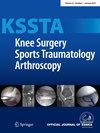Outcomes after multiligament knee injury worsen over time: A systematic review and meta-analysis
Abstract
Purpose
Multiligament knee injuries (MLKIs) are devastating injuries that can have life-long consequences. A management plan requires the decision to perform surgery or not, timing of surgery, consideration of repair versus reconstruction, reconstruction technique and reconstruction graft choice. The purpose of this study was to analyze development of clinical outcomes of MLKIs over time at a minimum of 2 years of follow-up.
Methods
Four databases were queried for surgical outcome-based studies of MLKIs published from 01/2000 through 09/2022 with a minimum 2-year follow-up. Technique articles, nonoperative treatment, arthroplasty, pediatric and review articles were excluded. Study characteristics including design, number of patients, age, follow-up period, anatomical region and posterior-cruciate ligament (PCL)-based injury were collected. Primary outcomes were Lysholm, International Knee Documentation Committee (IKDC) outcome scores and Tegner activity score. Random-effects model analysis was performed.
Results
After the application of inclusion and exclusion criteria, 3571 patients in 79 studies were included in the analysis. The mean age at surgery was 35.6 years. The mean follow-up was 4.06 years (range 2–12.7). The mean Lysholm score at 2-year follow-up was 86.09 [95% confidence interval [CI]: 82.90–89.28], with a yearly decrease of −0.80 [95% CI: −1.47 −0.13], (p = 0.0199). The mean IKDC at 2 years was 81.35 [95% CI: 76.56–86.14], with a yearly decrease of −1.99 [95% CI: −3.14 −0.84] (p < 0.001). Non-PCL-based injuries had a higher IKDC 83.69 [75.55–91.82] vs. 75.00 [70.75–79.26] (p = 0.03) and Lysholm score 90.84 [87.10–94.58] versus 84.35 [82.18–86.52] (p < 0.01) than PCL-based injuries, respectively.
Conclusion
According to the present systematic review and meta-analysis of MLKIs with minimum 2-year follow-ups, the patients who suffered an MLKI can expect to retain around 80-85% of knee function at 2 years and can expect a yearly deterioration of knee function, depending on the score used. Inferior outcomes can be expected for PCL-based injuries at 2 years postoperative.
Level of Evidence
Level IV meta-analysis.


 求助内容:
求助内容: 应助结果提醒方式:
应助结果提醒方式:


